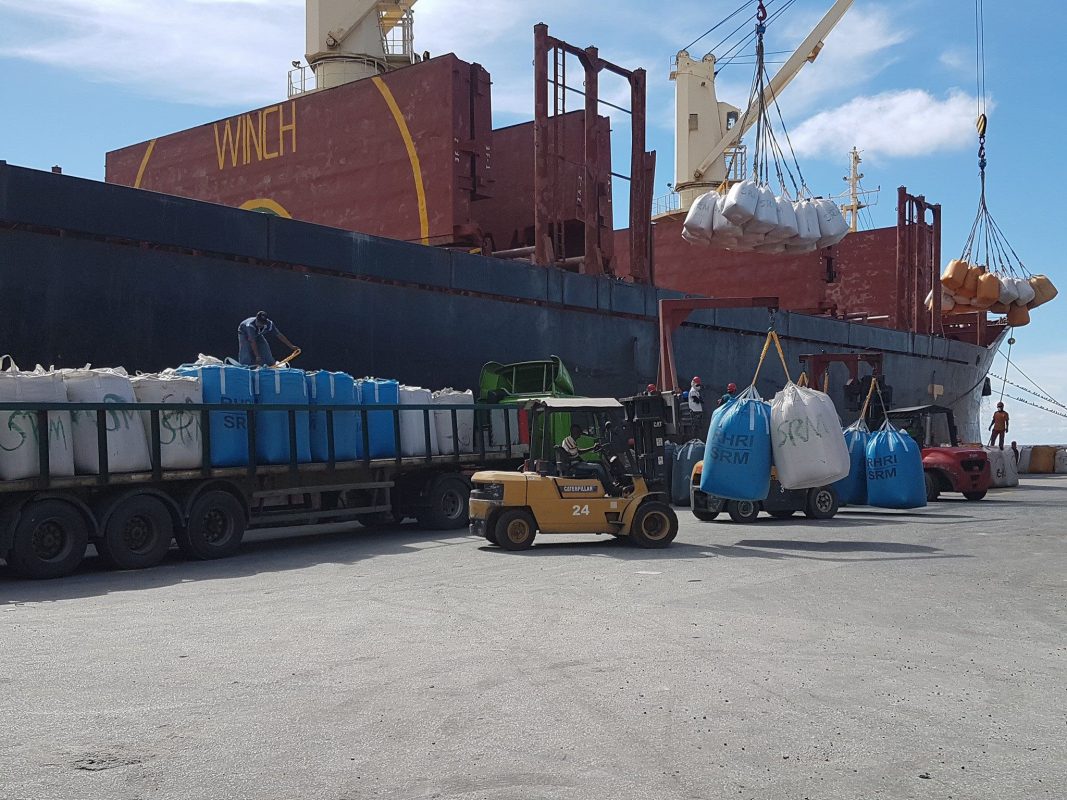Citing high production costs, rice farmers across the country are still to be convinced that government’s recent announcement that they will be paid at least $4,000 per bag of paddy will bring any relief to them.
The farmers also said that given their understanding of the industry, government’s removal of the sales commission from rice exports will be to the benefit of millers and not farmers.
Last Saturday, government brokered an agreement with the Guyana Rice Millers and Exporters Association (GRMEA) which will see the export levy paid to the Guyana Rice Development Board (GRDB) being lifted for the first crop of this year. This agreement will translate into millers having more cash at their disposal to purchase paddy at a higher price. An estimated US $1.5 million is returning to millers’ pockets under the deal.
The announcement of the decision last Saturday comes on the heels of a meeting with President Irfaan Ali, Vice President Bharrat Jagdeo, Minister of Agriculture Zulfikar Mustapha and GRDB officials and the association.
Farmers who spoke with Stabroek News contended that the price proposed will not allow them to be profitable as they wish. Depending on the yield and the grade of the rice, the price offered might only be favourable to a fraction of farmers.
From the millers’ end, Rajendra Persaud of Nand Persaud Company Ltd, a member of GRMEA, said they are finding it difficult to remain competitive as rice from Guyana is being sold at a higher price than from other markets in the US, Argentina, and Asian countries, thus making it difficult to pay farmers more for their paddy.
He expanded by saying the international market is currently saturated with rice from other countries, where it is being cultivated at a cheaper cost, and therefore being sold for a cheaper price.
“Our competitors are more profitable because they are having higher yields per hectare and are using technology as part of their cultivation. If we are entering the market with a tonne of rice at a higher price than our competitors who are offering the same product at $200 less, customers will go to the cheaper producers,” Persaud explained. He pointed out that markets close to Guyana, such as Venezuelan and Mexico are being inundated with cheaper rice and even when freight costs are factored in, the countries still save.
The plight of rice farmers was recently highlighted when Region Two farmers walked out of a meeting with the Agriculture Minister at the Rice Producers Association (RPA) bond at Anna Regina, Essequibo, in February. They were demanding a higher paddy price and lamented that other sectors of the country are getting assistance but they were not. They argued that rice farmers in the region are cash-strapped and cannot afford to plant another crop.
The minister, after speaking briefly with farmers, had told them that he was there with his team to listen to their concerns individually. He was accompanied by officers from various departments within the sector to address their issues.
As he called on them to raise their concerns, disgruntled rice farmers walked out saying that they wanted to air their problems publicly and went out and stood outside. Mustapha told those persons present that he had an agenda for the outreach and that he was there to have a one-on-one discussion with persons to listen to their concerns.
A large-scale rice farmer, Fizul Khan, was also very vocal. He was standing outside and announced that he would be waiting to speak to the minister outside. Khan cultivates 320 acres of rice lands and related that currently, rice farmers are crying out for better prices.
“Presently it costs a rice farmer about $115,000 per acre to produce and last crop, rice farmers only get $65,000. It is really hard on us, this government needs to do something.”
A farmer from Region Five, another large rice cultivating community, who preferred to remain anonymous, said that the deal should not have been struck with the millers and government but rather farmers and the government.
Slap
“It is like a slap in our face because we know what we are saying and the challenges we face in planting rice…” The farmer, who has been consulting with other farmers, also stated that if government agencies interact with farmers they will have a fair idea of the problems they face and will not make decisions based on advice from millers.
The Region Five farmer also called for the ending of the “monopoly” by large millers in the sector. He stated that the millers are the ones responsible for some inputs into the market and this influences the prices.
A rice farmer from Region Four, Sarju (only name given), informed that it cost between $115,000 and $120,000 to cultivate an acre of rice.
“$4,000 for a bag at 30 bags per acre [$120,000 per acre] is not profitable because the production cost is high and you have other expenses to cover… I don’t know what we are heading for because some millers were offering $3,800 per bag at Cane Grove, Mahaicony.”
Another farmer, Rambarack (only name given) of Region Three, stressed that the uncertainty concerning the price for rice is bewildering to them. He explained that the price offered now is lower than what they closed off the autumn crop in 2022 with. From that crop, he stated that they managed to stay afloat with paddy sold at $4,200 per bag and a fraction of their fertilizer being subsidised by the government.
“This crop we didn’t get any subventions and we are getting less price. We were really hoping they would have offered us $4,500 per bag of rice… that would have put us in a better position.”
He noted too that the yields for this crop might not be in their favour as the weather conditions were not suitable and this will likely result in low yields and grades.
“I don’t see how small farmers will be able to come back from this crop because the price is barely covering the cost and many farmers have to pay their loans still.”
Nazir Khan, a farmer of Black Bush Polder, Region Six, one of the largest rice cultivation zones in the country, said the $4,000 price should be reasonable once millers do not penalise farmers for grain quality.
He explained that in the industry, the highest price is paid for grade ‘A’ grains while a $100 is deducted for lower grains and the moisture retained.
“I only hope we get some benefits and the removal of the (sales commission) is passed down to compensate farmers.”
In Region Two, where rice is the largest contributor to the local economy, farmers expressed concern. “We hope it trickle down to we and millers don’t rob we.”
The rice farmer, who asked not to be named said he hopes the agreement that was signed will be to the benefit of rice farmers. He posited that it was necessary that farmers be satisfactorily compensated as the cost of production is not cheap.
He added that for the last crop, fertilizer prices were very high and farmers had to pay as much as $16,000 for potassium, Triple $14,000 and $13,500 for urea. He is calling on the government to intervene in the fertilizer prices.
Sunil Maniram, a rice farmer also from Region Two remarked that while he is happy the industry is receiving some attention and issues are being addressed, he believes a representative from the GRDB should be present at the mills when farmers are offloading their paddy. It is alleged that millers are shortchanging rice farmers with the weight and the moisture content.
“It’s a great thing but guess what, if the miller robs we with weight and moisture then it nah mek sense ’cause its same square one, we need representation at the mill cause millers doing what they want.”
Another farmer, Amir Baksh, welcomed the announcement by government, however he is hoping that further interventions can be made. He echoed the call for representatives at the mill especially when the paddy is being weighed.
Farmers, in the region are also calling for an additional subsidy of $1,000 on each bag of paddy to help them offset their overhead expenses.
“Monster in the room”
Nevertheless, Persaud told this newspaper that the high land rentals compounded with weather conditions and low yields per hectare are contributors to previous crops not being highly profitable for farmers.
In a bid to reverse the curse the industry is faced with, they are working with government to test better yields and look at utilising technology to improve production.
However, he was quick to point out that the “monster in the room” is the high prices farmers are paying for the rental of lands. The current land rent is between $600 and $800 per acre, which he opined should not be.
When rice was performing well a few years ago, many farmers took the decision to increase their cultivation. This created a competitive environment where farmers were bidding for lands that were abandoned by owners, who migrated overseas.
Some farmers also complained about this challenging situation and called on government to re-examine the issuance of leases for lands especially for those whose owners are no longer resident here and are renting to farmers.
Direct subsidies
Farmers from across the coast told this newspaper they would have been more satisfied if government would have implemented measures that would directly benefit them. They opined that subsidies on fertilizers, pesticides and weedicides, labour, and other overhead costs would help them significantly to recover their capital input. These measures, they related, would allow them to also contribute to having better market prices.
On February 7, farmers from regions Two, Three, Five, and Six, met with Mustapha to discuss some of the issues they faced in the industry.
A press release from the Ministry of Agriculture noted that while most of their issues were a result of unfavourable weather and external economic factors, the farmers have also called on the government to intervene in what they considered to be price gouging by suppliers of spare parts.
The farmers said that while the government has put systems in place, they are still paying high prices and, in some cases, VAT on spare parts.
“On the removal of VAT on spare parts, the government really do a good for us but the problem is we not feeling the effect. Everything raising. While these things are in place by the government, the prices still high and growing every day. The issue is now between the government and the dealers because we know for a fact that the VAT is supposed to be deducted but it’s like it’s not. I bought a starter yesterday for $46,000. It used to be for $25,000. Look at the markup. Some of them still charging VAT. I have a receipt to prove it,” a farmer charged, according to the release.
Furthermore, the farmers told the minister that the price for paddy should be standard in every region since all farmers are faced with the same issues.
The release said that Mustapha explained that the government, since taking office has implemented a number of measures to aid farmers, the most recent being the $1 billion fertilizer assistance programme that was completed last year.
He added that although farmers are requesting an across-the-board price increase for paddy from millers, the government cannot institute this because transportation costs play a significant role in the price for paddy in certain areas.
“We will continue to engage the millers on prices but I cannot promise an across-the-board price for paddy. For instance, in Region Two, the price to transport will be more than in Region Five, so in order for millers to earn, they take those factors into consideration. You know for a fact last year we were able to negotiate with millers from Region Two for better prices for farmers and now you are getting up to $4,000 per bag”, the release added.








